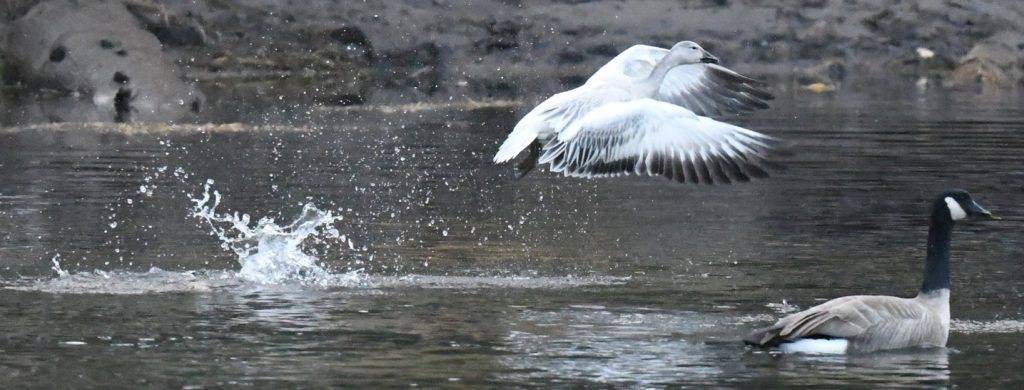
By Sevilla Rhoads
Special thank you to Marilyn and Craig Miller for inspiration, information, and editing.
Glistening frosts crystallize the Upper Deschutes’ river meadows in October and November. A few sparrows and kinglets (both Ruby-crowned and Golden-crowned) rustle the Willows’ browning leaves. Warbler migration trickles to an end. Eventually, only a handful of hardy Yellow-rumped Warblers are left to fight over the dwindling supply of insects.
When you enjoy watching birds, there is never a ‘bad’ time to bird because the end of one species’ season is just the beginning of another’s. The first snow clouds scudding over Bachelor may wave goodbye to warblers, but that same wave is greeting thousands of migrating geese.
Whereas our September night skies were filled with songbird peeps (over seven million passed over Deschutes County during the 2022 autumn migration), starting in October, the chilled air carries to our ears the sound of migrating wild geese. Mary Oliver describes this sound as “Harsh and exciting.”
The Upper Deschutes’ area waterways attract several goose species. Coming across a flock of geese, most of us assume they are only Canada geese. However, in the winter it is worth pausing to watch the flock more closely because there are often less common goose species among the crowd of Canada.
During their migration from the Arctic Circle, Greater White-fronted geese (Anser albifrons) enjoy grazing the emptying golf courses and floating the Upper Deschutes. A soft brown overall, the adults’ chests have variable black streaks. Their bills are pink or orange with an upper white fringe just before their gentle chocolate eyes. The legs are usually a muddy orange. When these geese take off, you see a U of white on their backsides. https://www.allaboutbirds.org/guide/Greater_White-fronted_Goose
When we hear the Greater White-fronted bleating above, we love to wait and watch as they repeatedly circle before landing. This circling habit allows us to appreciate all the variations in black chest markings. As if an artist flicked black paint across the front of each goose, every adult is an individual work of modern art. The juveniles often lack chest markings and the white fluff above the bill.
In the Pacific Northwest, there are several rare Greater White-fronted sub-species including the “Tule” (A. a. eglasi) and “Pacific” (A. a. Sponsa.) The “Tundra” (A. a. gambelli) winters from the Rockies eastward, and rarely if ever wanders to the west.
There are only an estimated seven thousand Tule left. However, the Tule sometimes migrate through this area to rest at Summer Lake before continuing south to winter in California. They are hard to identify but look for a goose resembling a larger and darker brown White-fronted.
Around mid-October, when the surrounding peaks don their white winter outfits, we get excited to spot the season’s first Snow geese (Anser caerulescens). https://www.allaboutbirds.org/guide/Snow_Goose/ This year we found our first 2022 Sunriver winter Snow Goose on October 21st. It landed on the Deschutes, near the Nature Center, with a large group of Canada geese. It was a juvenile, likely a year or two old. For several days, this youngster delighted us by staying in the area to rest, preen, and forage along the river banks and islands.
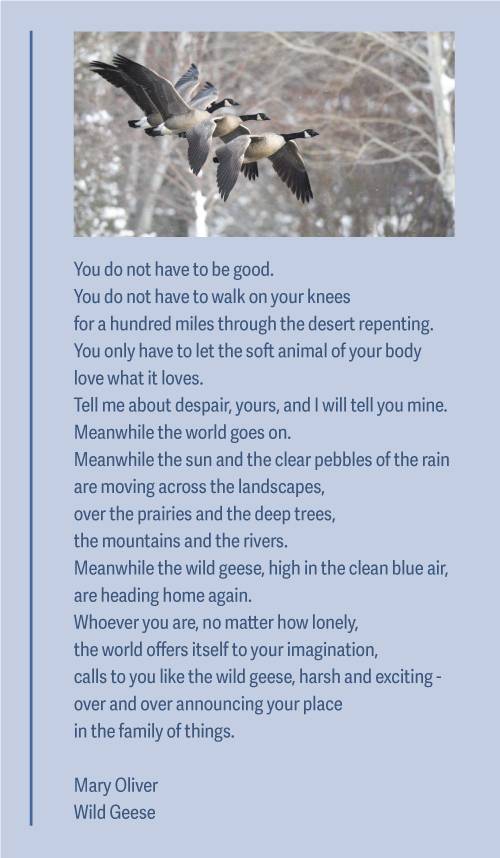
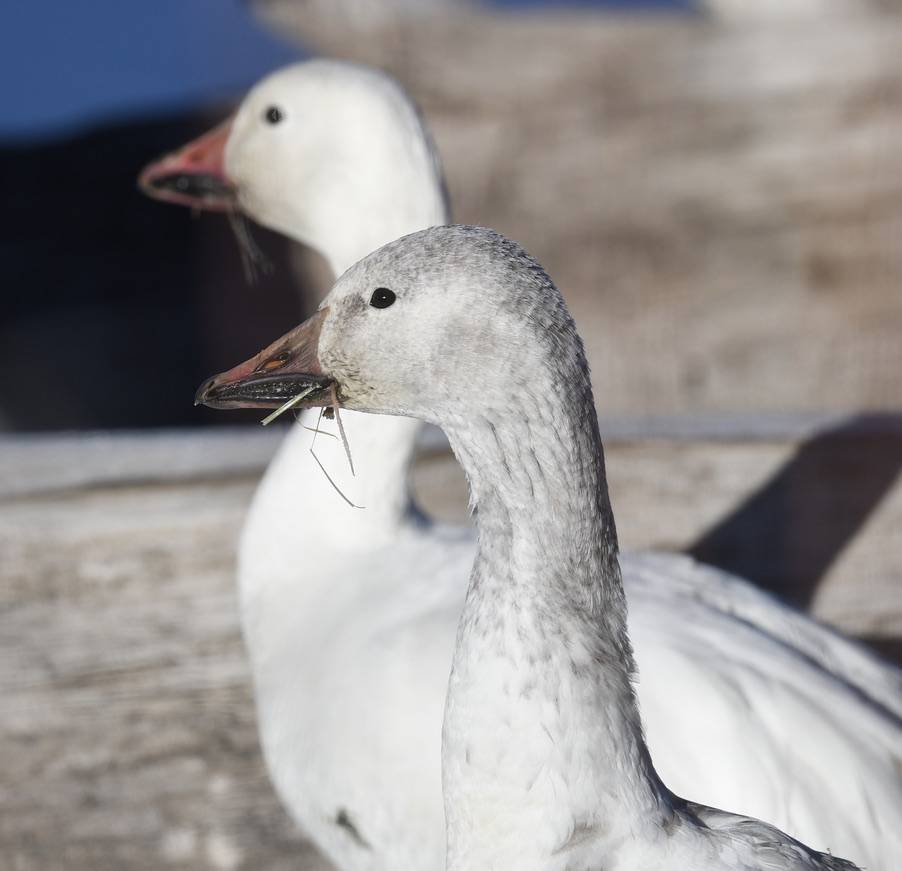
Later in October, a pair of Snow geese, an adult and a juvenile, turned up on the driving range by the Resort. Dodging golf balls, they grazed alongside a Greater White-fronted Goose for several days. This pair was likely a parent and child. Geese tend to have strong family bonds, with some families staying together for life, which can be over twenty years.
Back in February 2022, for several weeks, we watched another likely parent and child pair of Snow geese as they grazed around the Nature Center wetlands and meadows by the airport. Sadly, we later found the youngster’s remains, likely eaten by a coyote in the night. The adult was swimming in circles on the river nearby as if undecided whether it could leave the body of its child. Finally, it took off and flew north later that day.
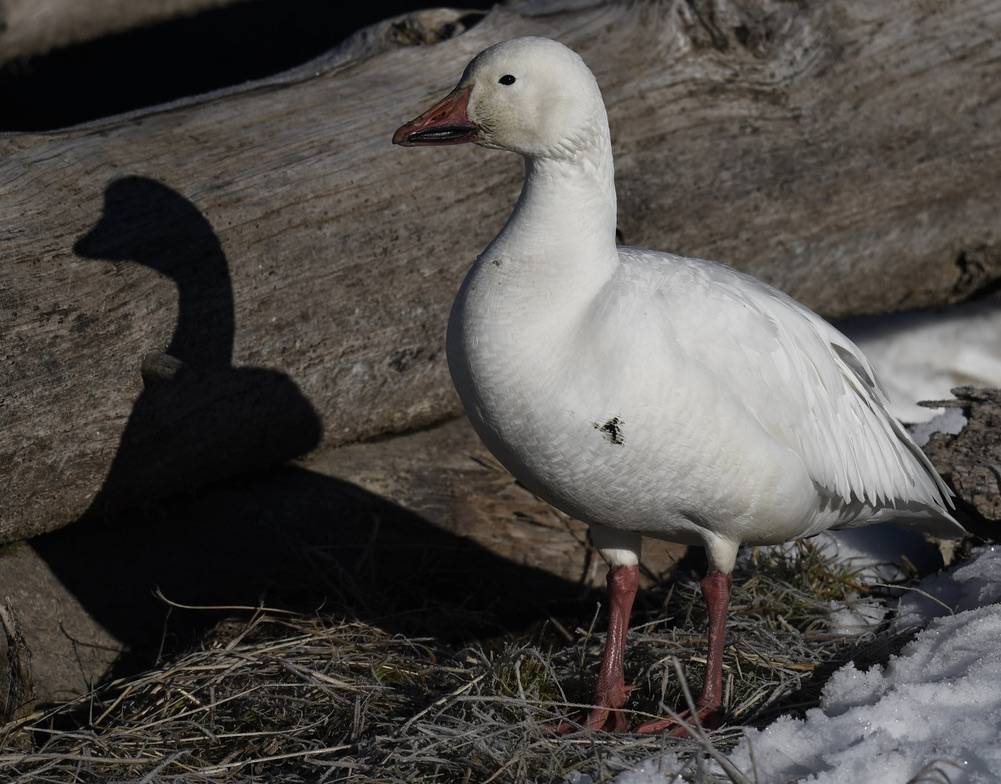
Geese are protective of their families with strong and long-term partner and child bonds. The adult Snow Goose likely fought and chased the coyotes that night, but in late winter, the predators are often lean and hungry so would not have easily given up a plump goose meal.
Speaking of hungry predators, scientists speculate Snow geese may be a critical new food source for Polar Bears. Researchers noticed Polar Bears are learning to hunt geese and eat their eggs when forced onto land due to the loss of their ice habitats. However, not evolved for goose hunting, the bears expend a lot of energy in the wild goose chase and may not get sufficient calories for this output.
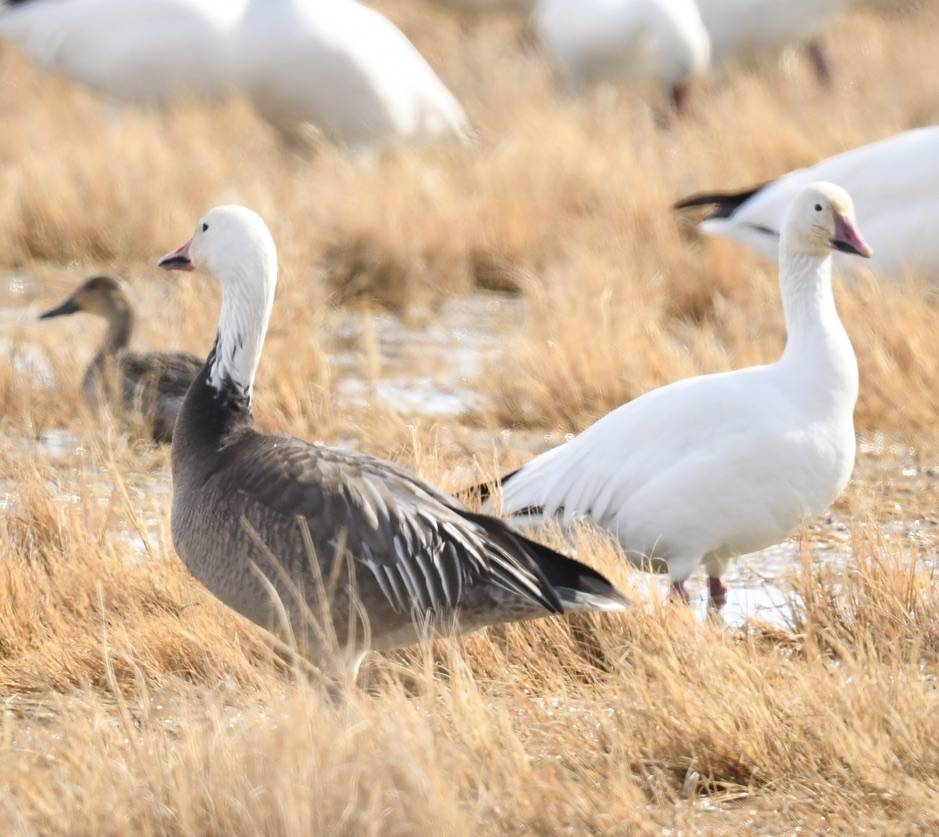
The Snow Goose population has sharply increased since the 1970’s. Primarily due to increased agriculture creating abundant winter food combined with laws that prevented indigenous peoples from traditional goose hunting, wild geese numbers threatened the health of their tundra breeding areas. Traditionally, the Inuit and Cree people depended on “Light Geese” (Snow and Ross’s Goose) as a food supply. The Canadian government has now partnered with the Inuit to figure out how to manage the goose population issue.
Not all Snow Geese are light-colored. There are occasional ‘blue’ Snow Geese. Once thought a separate species, DNA testing found blue geese are a single gene color morph. Scan flocks of geese passing through the Upper Deschutes and you may be lucky enough to spot a blue morph.
Ross’s Goose (Anser rossii) is another species that migrates over the Upper Deschutes. While they rarely stop around Sunriver, you may be fortunate enough to find one here. They are smaller than the Snow Goose and lack its dark area on the lower bill. They usually have more of a blue grey on the base of the bill and the black wing tips look different. https://www.allaboutbirds.org/guide/Rosss_Goose/species-compare/59939451.
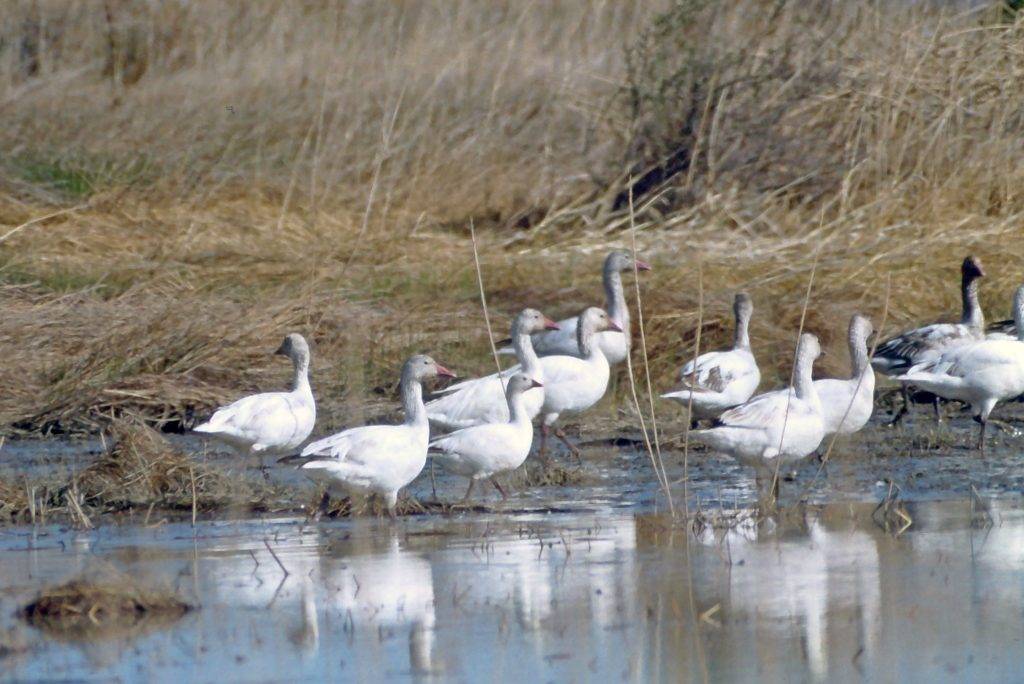
One reason even massively strong Polar Bears expend too much energy trying to steal goose eggs and chicks is the goose’s superior guarding skills and protective loyalty to home and family. Throughout history, people have partnered with geese to protect and detect. Geese and dogs are the oldest domesticated animals. Some, including the ancient Roman Pliny the Elder, consider geese better security animals than dogs. Pliny claimed a goose battalion saved Rome from a surprise attack in 390 BC, where the dogs failed to detect the approaching invaders. The U.S. Army has used geese to guard military installations. Currently, the Chinese government utilizes geese to assist in policing its COVID lock-downs and borders. https://www.nationalgeographic.com/animals/article/why-china-is-using-guard-geese-to-uphold-its-zero-covid-policy
Maturing whiskey is highly valuable in Scotland. In 1959, an ingenious engineer with a birding background persuaded a Scotch producer to try geese as security for its new fourteen-acre maturing warehouses. https://scotchwhisky.com/magazine/whisky-heroes/26782/scotch-watch-the-ballantine-s-geese/. Not a single dram was stolen during the goose patrol years which lasted until 2012 when cameras took over. It is questionable whether the cameras were an improvement because the geese not only kept thieves away, but also neatly trimmed the grass and produced eggs which were sold for food. The egg profits were donated to a nearby veteran’s hospital.

Why do geese provide such good security? Not only fiercely devoted to their family and home area, geese also have excellent eyesight and hearing. They can separately control each eye and hear faint noises in the distance. Geese can also keep part of their brains and their eyes alert while they sleep. This special unihemispheric slow brain wave state (which essentially means sleeping with half the brain alert) allows a focused vigilance to occur during necessary rest. Great frigatebirds use this watchful sleep mode to stay in flight for weeks over the ocean. https://www.audubon.org/news/scientists-finally-have-evidence-frigatebirds-sleep-while-flying
One of our favorite Sunriver winter scenes is Canada geese (Branta canadensis), perched on one foot, sleeping on the river ice flows. Like a black and white sketch of the surrounding monochrome landscape, their heads draw down curved, black necks which bury into waves of soft brown down. They watch us pass with one eye, barely untucked, open in their half-sleep. Gentle grunt-sighs reassure the rest of the flock we are harmless. The geese’s soothing utterings cushion the sound of our feet crunching the frozen snow.
During the 1900s, the proliferation of lawns, mowed grass, and agricultural fields caused Canada geese to reduce their migrations and increase their populations. Rather than being praised as masters of adaptation for thriving despite loss of their natural habitats, many people view Canada geese as pests. In contrast, wild geese are celebrated by many Native American tribes and First Nations. If you look at indigenous people’s moon calendars, many full moon names relate to geese. For the Northwest Tlingit, January’s full moon is the goose moon, as is the further north Haida’s February full moon. Goose hunting is woven into the cultural fabric of some people. https://www.audubon.org/news/for-these-cree-first-nations-canada-geese-are-central-cultural-revival
If geese are considered a problem in your area, experts suggest replacing grassy areas with native plants and trees. Further, you can support efforts to protect their natural predators like wolves, cougars, and foxes. Some parts of the Deschutes attract large flocks of Canada geese because the unnaturally low winter river levels expose tasty vegetation. Geese are herbivores and normally seek the best access to greens and grains.
There are sub-species of Canada Goose. In 2004, a group of the smaller sub-species were re-classified as a new separate species called the Cackling Goose. https://www.allaboutbirds.org/guide/Cackling_Goose/overview. Cackling geese have their own sub-species. For most of us, it is a challenge to distinguish a Cackling from a Canada, so have no shame if you leave figuring out Cackling sub-species to the goose experts!
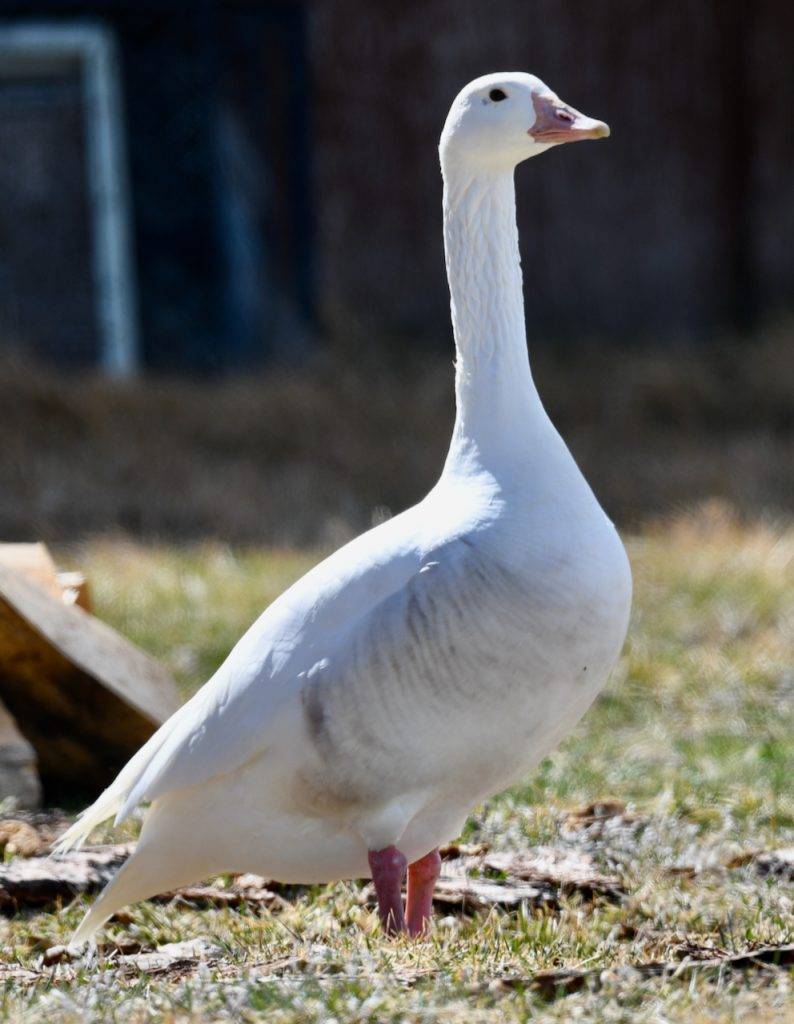
Every once in a great while, you may see rarer goose species in the Upper Deschutes like an Emperor (https://ebird.org/species/empgoo/US-OR-017), Tundra Bean (Anser serrirostris) or a Brant (https://ebird.org/species/brant/US-OR-017). You also could come across an escaped domestic or guard goose.
So, next time you hear geese calling from above or encounter a gaggle of geese in a park or out in the wild, consider pausing to listen and notice their details. You may see unusual goose species, plumage, and size variations as well as interesting behaviors.
